Related Blogs
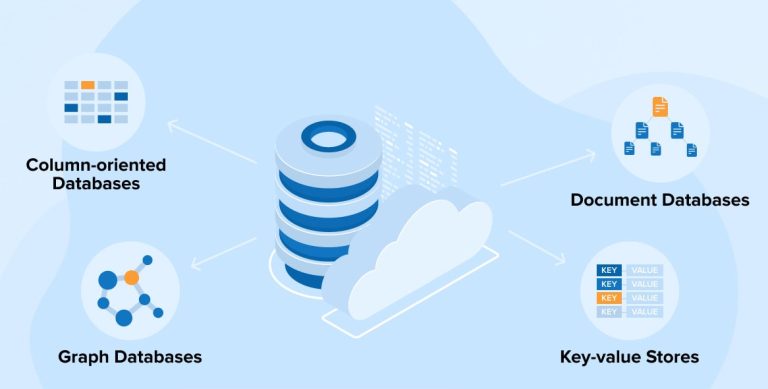
NoSQL databases have seen a surge in popularity since its global introduction. Developers looking for the alternatives to the rigid architecture of relational databases can consider NoSQL for its adaptability and scalability.
Many software development companies utilize NoSQL databases to keep track of information like operational parameters, functionalities sets and models’ metadata. However, they are useful to data engineers for archiving and recovering data.
Before delving into NoSQL’s significance, let’s discuss the types of NoSQL, its features, benefits and drawbacks so that you can divide them appropriately according to your project objectives and needs.
1. What is NoSQL Database?
In lieu of rows and columns, the NoSQL database systems store data as JSON files. To clarify, NoSQL stands for “Not only SQL”. It refers to any “non-relational database”. This implies that a NoSQL database may keep and access data without utilizing SQL or you may mix the flexibility of JSON with the capability of SQL. NoSQL databases are therefore designed to be adaptable, accessible, and adept at swiftly reacting to the data management needs of modern enterprises. Traditional Relational database uses SQL syntax to store, manage, and retrieve data while NoSQL database system uses wide range of database technologies that can access structured, semi-structured, and unstructured data with equal effect.
2. Types of NoSQL Database
Following are descriptions of the four most common NoSQL database kinds:
- Document databases
- Key-value stores
- Column-oriented databases
- Graph databases
2.1 Document Databases
A document database holds information in a document format such as JSON, BSON, or XML (not Word documents or Google Docs). In a document database, files can be stacked. Certain items can be indexed to facilitate speedier querying.
Documents may be saved and accessed in a manner that is far nearer to the data items used in software, requiring less interpretation to utilize the information in an application. Frequently, SQL data must be constructed and dismantled while traveling across apps and storage.
Document databases are preferred with engineers since their document formats may be reworked as required to fit the program, and their data structures can be shaped as prerequisites that evolve over time. This flexibility accelerates the software development process since data are effectively treated as code and are under the command of developers. To modify the structure of a SQL database, database administrators may be necessary to intervene.
The most extensively used document databases often have a scale-out design, which provides a clear route to flexibility in terms of both data capacity and traffic.
Industry-specific use cases comprise ecommerce systems, online trading, and mobile application development.
1. Key Features of Document Databases
- Configurational pliability : The database’s documents follow an adaptable structure which essentially means that the documents in the database might have different schemas.
- Minimize the time required for both development and maintenance : Once a document has been created, there is very little work involved in keeping it up to date.
- No foreign keys : Because papers are not bound to one another in any way, they can exist independently of one another. Foreign keys are thus unnecessary in a document database.
- Freely available formats : Documents are created with XML, JSON, and other forms.
2. Advantages of Document Databases
- Open and scalable data model, and without any “foreign keys”
3. Disadvantages of Document Databases
- Limiting searches to primary keys and indexes is a drawback, and you’ll need to use MapReduce for complex inquiries.
Example:
JSON [ { "year" : 2021, "title" : "Eternals", "info" : { "director" : "Chloé Zhao", "IMDB" : 6.3, "genres" : ["Science Fiction", "Action"] } }, { "year": 2022, "title": "Doctor Strange in the Multiverse of Madness", "info": { "director" : "Sam Raimi", "IMDB" : 7.0, "genres" : ["Science Fiction", "Action", "Superhero"] } } ] |
JSON [ { "year" : 2021, "title" : "Eternals", "info" : { "director" : "Chloé Zhao", "IMDB" : 6.3, "genres" : ["Science Fiction", "Action"] } }, { "year": 2022, "title": "Doctor Strange in the Multiverse of Madness", "info": { "director" : "Sam Raimi", "IMDB" : 7.0, "genres" : ["Science Fiction", "Action", "Superhero"] } } ]
2.2 Key-Value Stores
A key-value store database is the most elementary form of NoSQL database. Attribute names (or “keys”) and their associated values (or “values”) are used to represent each and every piece of information in the database. In the Key-value stores database, every element is stored as a key value pair. For Example, the key or attribute name like “city” and the data or value like “Bangalore”. Ecommerce carts, user information, and choices are some of the examples of possible applications.
1. Key Features of the Key-Value Store
- Easily scalable
- Mobility
- Rapidity
2. Advantages of Key-Value Store
- Value may be expressed in a variety of formats, such as JSON, XML, and flexible schemas, and the underlying data model is simple, scalable, and easily understood.
- Because of its ease of use, it can process data quickly, and it works best when the underlying information is not closely connected.
3. Disadvantages of Key-Value Store
- There are no connections; you must generate your own foreign keys.
- Lacks scanning abilities; not great for anything but CRUD; not suited for complicated data (create, read, update, Delete )
Example:
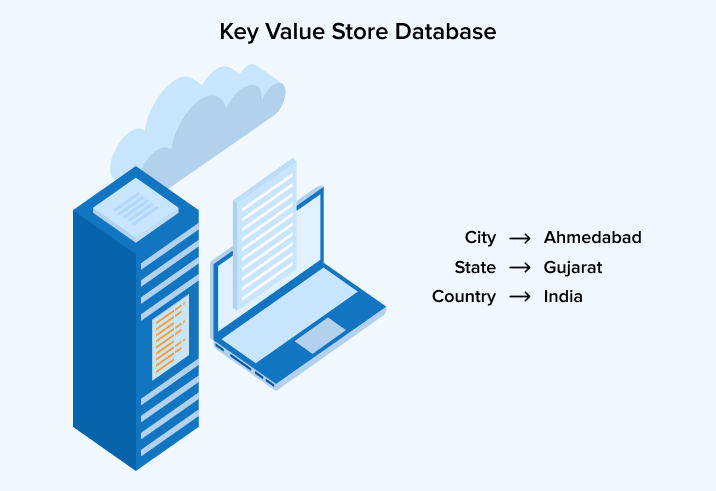
2.3 Column-Oriented Databases
A column store, in contrast to a relational database, is structured as a series of columns, rather than rows. This allows you to execute analytics on a subset of columns without worrying about the rest of the data eating up storage. Read speeds are improved due to the fact that columns of the same kind may be compressed more effectively. The value of a column may be easily aggregated in columnar databases. Analytics is a common application of column-oriented databases.
Whereas columnar databases excel at analytics, its inability to be firmly consistent is a major drawback due to the fact that updating all columns necessitates numerous writes to disk. Due to the row data being copied sequentially to disk, relational databases are immune to this issue. Column oriented databases are widely used to manage data warehouses, CRM, business intelligence data, etc. Some of the column oriented database examples are Hbase, Cassandra, and Hypertable.
Further Reading on Hbase vs Cassandra
1. Key Features of Columnar Oriented Database
- Extensibility
- Flexion
- Receptive to the slightest of prompts
2. Advantages of Columnar Oriented Database
- Scalability
- Natural indexing
- Support for semi-structured data
- Access time
3. Disadvantages of Columnar Oriented Database
- Cannot be used with relational data
Example:
Suppose, A database has a table like this:
| RowId | StudentName | Maths Marks | Science Marks |
|---|---|---|---|
| 001 | John | 98 | 85 |
| 002 | Smith | 85 | 99 |
| 003 | Adam | 75 | 85 |
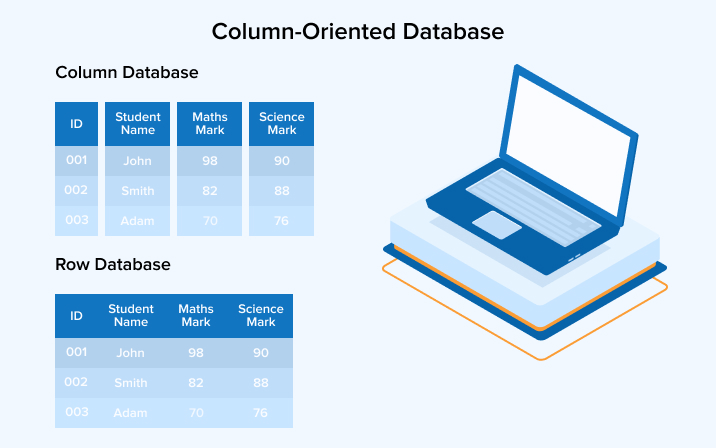
2.4 Graph Databases
A graph database is designed to highlight the connections between data points. An individual “node” represents each piece of information. Links or relations are the interconnections across multiple elements of a total. Connections are directly recorded as first-class items in a graph database. Data connections are expressed through the data itself in relational databases, thus ties are assumed rather than explicitly written.
Because of the inefficiency of joining many tables in SQL, a graph database is better suited to storing and retrieving the relationships between data items.
In practice, only a small handful of enterprise-level systems can function well using only graph queries. Consequently, graph databases typically coexist with other, more conventional types of NoSQL databases. Cybercrime, social media, and knowledge graphs are some of the applications of it.
Even though they share a name, NoSQL databases are quite different from one another in terms of their underlying data structures and potential uses.
1. Key Features of Graph Database
- One of the main features of a graph database is that it is straightforward to see how various pieces of information are connected to one another by way of the hypertext connections between them.
- The output of the Query is current, up-to-the-moment information.
- How quickly anything happens is proportional to the complexity of the interconnections between the various parts of the database.
2. Advantages of Graph Database
- Super-effective
- Locally-indexed connected data
- ACID support
- Instantaneous output
- Flexible architecture
3. Disadvantages of Graph Database
- Scaling out is challenging, however scaling up is possible
Example:
Employee Table:
| Emp_ID | Employee Name | Age | Contact Number |
|---|---|---|---|
| 001 | John | 25 | 9475858574 |
| 002 | Smith | 26 | 7485961231 |
| 003 | Adam | 24 | 7412589634 |
| 004 | Johnson | 22 | 9874563521 |
Employee Connections Table:
| Emp_ID | Connection_ID |
|---|---|
| 001 | 002 |
| 001 | 003 |
| 001 | 004 |
| 002 | 001 |
| 002 | 003 |
| 003 | 001 |
| 003 | 002 |
| 003 | 004 |
| 004 | 001 |
| 004 | 003 |
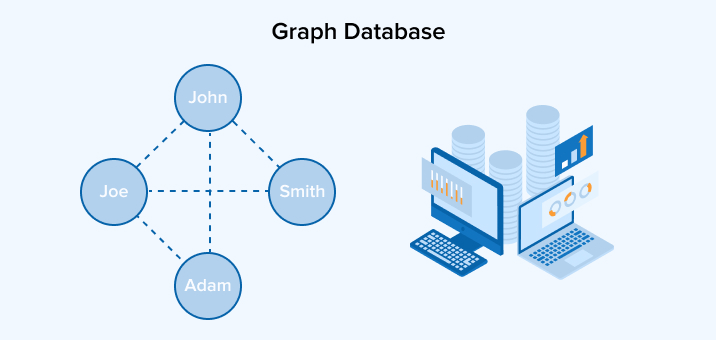
3. When to Use Which Type of NoSQL Database?
If you need to store and represent a wide variety of data types—including structured, semi-structured, and unstructured data—in a single database, you should look into a NoSQL database. In addition, NoSQL databases are more adaptable since the data we keep in them does not require a pre-established structure, as is the situation with SQL databases. Choosing the right NoSQL database for a given application can be challenging because each kind has its own unique characteristics. Consequently, it is important to get a sense of typical applications before making a database choice.
Please get in touch with our technical team if you need any assistance on that.

Vishal Shah
Vishal Shah has an extensive understanding of multiple application development frameworks and holds an upper hand with newer trends in order to strive and thrive in the dynamic market. He has nurtured his managerial growth in both technical and business aspects and gives his expertise through his blog posts.
Related Service
Custom Software Development Services
Learn more about custom software development services
Know MoreSubscribe to our Newsletter
Signup for our newsletter and join 2700+ global business executives and technology experts to receive handpicked industry insights and latest news
Build your Team
Want to Hire Skilled Developers?

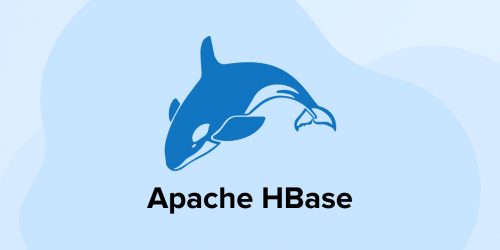
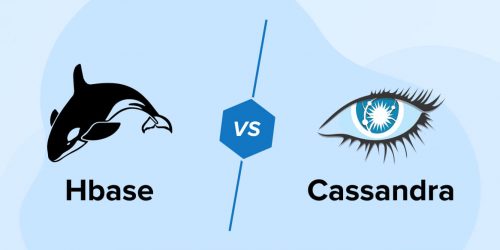
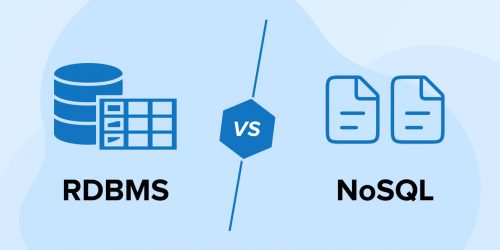

Comments
Leave a message...